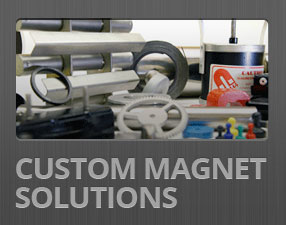How are permanent magnets made? Here’s how we do it in our onsite manufacturing plant.
We break it down to build it back up
Ceramic Ferrite, Samarium Cobalt (SmCo) and Neodymium-iron-boron (Neo) magnets are all made through a process called Powder Metallurgy.
We melt raw materials in vacuum conditions, then pour it into a mould or allow it to cool on a cooling plate.
These pieces are crushed to a fine powder, which become chemically reactive. Under the right (or maybe wrong) conditions, this dust can ignore spontaneously. Oxygen causes the reaction, so we have to keep the powder under vacuum conditions.
Squishing it back together
At this point we have to compact the powder back together and align all the particles so the magnetic regions point in a given direction.
The first method is through pressing pressing.
- Powder is placed into a cavity in a tool on the press and punches enter the tool to compress the powder.
- A moment before compaction, an aligning field is applied.
- The compaction locks in the alignment.
- Compacting powder in hydraulic or mechanical presses limits the shape to simple cross-sections that can be pushed out of the die cavity.
The second method is isostatic pressing.
- A flexible container is filled with powder.
- The container is sealed, hit with an aligning field, and placed into an isostatic press.
- Fluid pressure is applied to the outside of the sealed container, compacting it equally on all sides.
- Magnetic blocks are commonly manufactured through isostatic pressing because it can be done at larger sizes and, since pressure is applied equally on all sides, the powder remains in good alignment producing the highest possible energy product.
In both cases, following the pressing, magnets are heated to generate density.
Get the Shape and Size Right
Sintered magnets are finished, maybe grinding them smooth and parallel, maybe slicing block magnets into smaller parts. It depends entirely on your application.
The magnet material is brittle and very hard, requiring diamond wheels for slicing and diamond or special abrasive wheels for grinding.
All these processes are incredibly precise, to eliminate the chance of any chipping and cracking.
Coatings are applied at this point, before the magnet is fully magnetized.
Magnetizing
When the magnet is built, it has to be charged to generate a magnetic field.
This can be accomplished in a solenoid or with fixtures designed to impart unique magnetic patterns.
It is also possible avoid handling and assembling large magnetic assemblies by magnetizing en-mass. The fields required to complete this are substantial (and not inexpensive), but are a smart choice in several scenarios.
When your magnet is magnetized, it’s ready to go to work for you.
A permanent magnet is just about as true to its name as something can be. A custom magnet will serve your application dutifully for as long as you need it to, barring any damage to the magnet itself.
How are permanent magnets made? Carefully and precisely, to the requirements of any of our customers. We can custom craft magnetic solutions for your business with a quick turnaround and high quality control standards.
Design, manufacture and final testing are all done in the same place, our on-site manufacturing plant.
That means you get the quality you pay for every time.









-940x300w.jpg)




